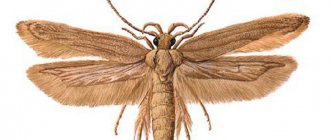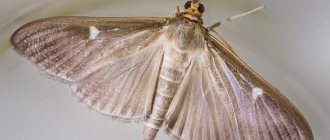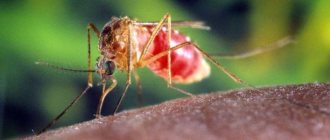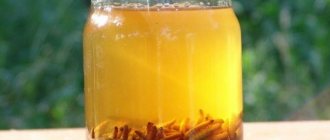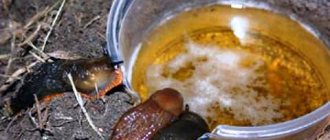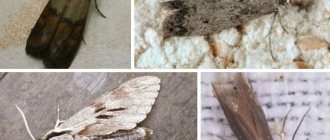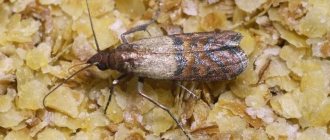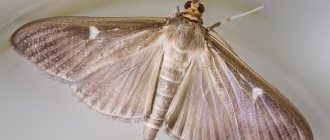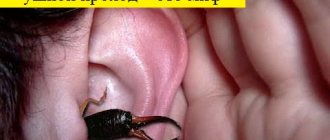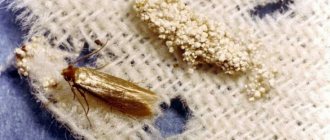Insecticidal properties
The fruits of horse chestnut, as well as its flowers, are excellent in getting rid of moths.
Interestingly, his peculiarity lies in his vulnerability. The fact is that horse chestnut trees are parasitized by the so-called mining moth, and since this insect has practically no enemies, it reproduces freely and can destroy an entire tree in a short period of time. Because of this, chemicals based on Imidacloprid are injected into the vessels of trees. It is this that saturates the leaves and fruits of the chestnut, thereby repelling moths.
Just a few nuts should be placed on the shelves of closets, as well as in the pockets of fur clothes, and the nasty insect will never get close to them. You can also use dried flowers of this tree, crushed and wrapped in fabric bags. They are also impregnated with Imidacloprid, like ripe fruits.
Fighting leafminer moths
There is also a type of moth called mining moth. The small insect got its name from the ancient word “mine,” which implies the creation of hidden passages. It is in this way that leaf miner caterpillars damage plant leaves from the inside. Moreover, it is very difficult to identify the pest externally: its presence is indicated only by the death of the plant.
Miner moth caterpillars feed on almost all types of fruit and berry plantings, flowers, weeds, ornamental and medicinal plants. If a leafminer moth is found on a site, how to deal with this pest? What techniques should be used?
In the fight against “miners”, the use of chemicals is effective, namely: “Bi-58”, “Karate”, “Dimilin”, “Confidor maxi”, “Aktara”, “Aktofit”. If there are several generations of leafminer moths, spraying should be carried out repeatedly.
How to deal with moths during the summer? To do this, in greenhouses and open ground, you need to hang plates, boards, and pieces of yellow plastic coated with glue, placing them at the level of the main leaf mass along the rows of plants. Before flying, attach adhesive belts to tree trunks.
It is also important to remove the affected parts of the plants and then destroy them manually. In the fall, it is imperative to clean up under the tree and compost fallen leaves, and carefully dig up the tree trunk circles
We will help you navigate among the numerous methods and means of pest control. We have selected the best of the best effective methods and wrote:
Step-by-step guides on how to get rid of pests yourself. We develop our guides based on scientific research and the opinions of award-winning biologists.
Whether you want to start your fight with something easier, or you have children and are concerned about their health, we have a review of the best natural cockroach product or child-friendly, safe mosquito repellent for babies and children.
How to get rid of a specific pest:
how to kill fire ants, get rid of termites, sewer flies, flies, fruit flies, wasps, bees, mosquitoes, cockroaches, fleas, fleas on cats, fleas on dogs, ticks, bedbugs, moths, dust mites, moles and gophers, rabbits, squirrels, raccoons, rats, mice.
When one product, termiticide or device is multifunctional and helps get rid of many pests, such as Yard Sentinel repels rats, mice, birds, bears, deer, dogs, cats, raccoons, ducks, squirrels, skunks, foxes, insects, so we do one but very complete review of this product. Yard Sentinel Electronic Repeller Review: How to Get Rid of Pests Without Poisons or Traps?
If there are two similar products
, and it's very difficult to tell the differences between them - we're doing a comparison to help you decide which device is the best solution to your problem - Rat Zapper Classic vs Rat Zapper Ultra Rodent Trap.
- How to get rid of mosquitoes
- Review of the best mosquito repellent
- Review of the best electric and propane mosquito sprayers
- Comparative review of two propane mosquito traps: Blue Rhino SV3100 vs Blue Rhino SV5100
- Review of MOSQUITO MAGNET TRAPS products: “INDEPENDENCE”, “PATRIOT” and “EXECUTIVE”
- Reviews of the Best Mosquito Traps: Homemade, UV, CO2, H2O and Propane Traps
You have 3 ways to get rid of rats and mice: pest repellent, trap or killing them. So you can read about them all and then make your choice:
- Repellent:
5 best and proven ways to get rid of rats: is repellent more effective than killing? + Review on Top 7 Electronic Rodent Repellers - Killing Rats and Mice
with Poisonous Baits - Getting Rid of Rats and Mice with Natural and Poisonous Baits - Trap and Kill Rats and Mice with
Electronic Rat Zapper Trap
Our guides are based on scientific research and the opinions of biologists. For example, during our research we found that ultrasonic repellents do not work against mosquitoes
. This is bad for manufacturers of such devices. But the fundamental theme for us is Truth. We try to provide you with reliable and useful information that will help you get rid of your problem.
Probably every housewife has encountered the problem of moths at least once in her life. Small gray moths fluttering around the apartment bring a lot of trouble to the owners, and disgusting white larvae make sensitive ladies faint. To remove them from the house and get rid of pests forever, use simple folk remedies or industrial preparations.
Methods of using chestnut against moths
To combat the pest, you can use both raw and dried chestnuts. They cope equally well with the pest, but raw fruits can only be placed in well-ventilated places, as otherwise they will become moldy and will be of no use. Therefore, it is best to collect the fruits and dry them in any convenient way, and then arrange them on cabinets and shelves.
How to prepare the closet and lay out the repellent:
- It is important , before arranging chestnuts in the closet, to put it in order.
- Take out all the things , wipe the closet well, and then put everything back.
- Place several pieces on the shelf between clothes.
- The fruits do not emit any odor and, if dried properly, will not stain clothes.
- The shelf life of chestnuts as a moth repeller is 2-3 years , but it is better to change them every year.
- Autumn came , they collected fresh fruits and replaced last year's ones with them.
Interestingly, chestnuts work better if they are split. To do this you should:
- Break the round pieces with a hammer into small pieces.
- Wrap them in fabric bags.
- Arrange between things on shelves.
Also, the flowers of this tree, which resemble white candles, are useful in the fight against the parasite. It is necessary to collect them, dry them and grind them into dust, then put them in fabric bags and place them in a closet.
How can these fruits be used to eliminate insects?
If a housewife needs to fight moths at home, then in this situation it is not necessary to use various chemically active substances. Both raw and dried chestnuts can help her here. At the same time, the effectiveness of both options 1 and 2 will be noticeable.
But if you decide to use raw fruits, then you can place them only in a room that will be very well ventilated in the future.
In unventilated places, raw chestnuts quickly become moldy, which is why their effectiveness is reduced several times. Therefore, it is advisable to first dry them in any way, and only then use chestnuts as a means of combating various types of insects.
In order to quickly get rid of pests, you should first prepare the cabinet, and only then arrange the fruits in this place:
- Before you put the finished product in any cabinet, you first need to do a thorough cleaning so that all things are in their place.
- First, you need to remove absolutely all things from the closet, wipe it well and ventilate it, and only then put them back.
- All the fruits that the housewife wants to use in the process of fighting such insects need to be laid out in such a way that there are several pieces between 2 things in the closet at once. And this action must be performed with absolutely all items of clothing located in the wardrobe or other place.
- If a person dries the fruits correctly, then not only will they not get dirty, but they will also not emit an unpleasant odor.
- A chestnut placed between things can serve as a kind of moth repeller for 2-3 years, after which it must be systematically changed.
- However, it is preferable to replace old fruits in your wardrobe every autumn with new ones collected in the current season.
If the housewife wants the efficiency of chestnuts to be higher, it is often recommended to simply split them before putting them in the closet. To do this, do the following:
- You need to break the fruit into very small pieces using a hammer.
- The resulting pieces need to be placed in some kind of fabric bag or simply wrapped in regular fabric.
- Bags with pieces of this product can be safely placed in the wardrobe between items of clothing and things.
If the owner adheres to these rules, he will be able to quickly get rid of insects at home.
The effectiveness of the chestnut method
If we talk about the effectiveness of the “chestnut method” of fighting moths, then we can safely say that all means are good against moths. The main feature of the chestnut is its ability to scare away moth butterflies, preventing them from laying new eggs.
At the same time, they cannot in any way harm the eggs that have already been laid and the hatched larvae. Therefore, these fruits are certainly effective as a means of repelling moths.
But if the butterfly is already flying, it means there are nests somewhere that can be gotten rid of in several ways:
- Throw away all contaminated items.
- If the clothes can still be saved , they should be washed and ironed.
- If the item is made of fur , it is necessary to expose it either to the sun or to frost. The insect cannot withstand both high and low temperatures.
- Use chemicals to control moths. This is the least attractive method as these substances are toxic to both insects and humans. Therefore, you should think twice about what is more important - a fur hat or your own health, which, unlike a hat, cannot be bought.
Chestnut is effective as a moth repellent, but is powerless if it has already started and laid eggs. Therefore, yes, it can and should be used in combination with other types of pest control.
In what cases is the method with chestnuts against moths effective?
Very often, many doubt that the “chestnut method” is an effective tool in the process of fighting moths. In fact, this method has its own unique feature, since only these fruits can scare away the butterfly itself, which is why they will simply not be able to lay new eggs in things. Naturally, chestnuts will not be able to get rid of the larvae themselves. But if the housewife notices a butterfly flying nearby, then they will not allow eggs to be laid in clothes with their smell. In the event that a person wants to 100% get rid of the butterfly itself, then he needs to perform the following actions:
- All contaminated items in your wardrobe must be immediately removed from your home and better thrown away.
- If the clothing is in a state where it can still be rehabilitated, then it must be washed as thoroughly as possible and preferably ironed with a hot iron.
- If the clothes in which the moths appeared are made of natural fur, then this product can simply be taken out either into the cold or into the bright sun. This must be done in order to scare her away, as she is afraid of bright light and severe frost.
- In extreme cases, you can resort to the use of chemically active agents, but this will be dangerous for both insects and people. Therefore, in this situation, you need to think 100 times about simply throwing away an item of clothing rather than completely ruining your health.
If people have moths in their clothes, then you can get rid of them by using chestnuts. But if adult butterflies have already laid larvae, then in this situation such a method will not be effective. Since it does not kill the larvae, sooner or later new adult butterflies will hatch from them.
What to combine chestnut with for greater effectiveness?
There are other folk methods of fighting moths, which can and should be combined with each other. These include plants such as:
- fir branches;
- tansy;
- citrus peel;
- dried lavender;
Plants should first be dried, placed in fabric bags and placed on shelves.
Strawberry soap is also very effective. Housewives have long placed it between sheets in chests, not only to give them a magical smell, but also as an anti-moth remedy.
It is important to remember that each of these remedies is powerless on its own, but in combination with each other they can rid the owners of the problem with nasty insects forever. Therefore, you should not stop at arranging chestnuts on shelves. You should also place bags of fragrant lavender and citrus peels on them. Also, other combinations are possible - whatever is at hand.
Preparing chestnut for use
In order for chestnut to bring maximum effect, you must adhere to several rules:
- Firstly, it is best to collect roundels in the fall , when they are already fully mature and the prickly crust has split, because only the brown glossy core is needed. The fruits of this tree ripen from the end of September to the end of November. It is during this period that you should stock up on glossy fruits
- Secondly, to prevent it from becoming moldy in the closet, it must be dried. Drying is carried out within 10-15 days. More is possible, but not less. You can dry it in any available way. Whether in the sun, or indoors on a newspaper, it doesn’t matter. The readiness of chestnuts is determined by their appearance. If they have acquired a matte tint and shrunk, then they are ready.
- Thirdly, the fruit should not stain clothes , so after it is dried, it should be thoroughly wiped with a dry napkin or rag.
Once it has been collected, dried and free of contaminants, you can begin to use it. It should be placed in the closet in random order between clothes. Also, you can and should put several fruits on the shelves in the kitchen, since chestnuts perfectly repel all types of moths, including food moths.
It is important to remember that it should be placed on the shelves before the larvae appear, because otherwise it will not help at all.
Harm from leaf miners
The insect is considered one of the most aggressive species of moth, which destroys leaves on trees at the highest possible speed.
Chestnuts damaged by moths.
During the season, female Ohrid leaf miners manage to give birth to 3 offspring. As the chestnut moth caterpillar grows in mining passages, the volume of plant matter it absorbs increases. Damage on leaves becomes visible already at the 4th-5th stage of development.
Leaf blades eaten away by caterpillars become covered with brown spots, begin to dry out and fall off. Due to massive damage to the leaf mass, trees do not have time to accumulate nutrients during the season, which leads to the freezing of chestnuts or the drying out of a large number of branches in winter.
In the spring, leaves on such trees do not bloom well; weakened plantings are more often susceptible to invasion by other pests (insects, fungi, etc.). In addition, the chestnut leaf miner serves as a carrier of viral infections that can infect trees and other plants.
Massive damage was noted by specialists in greenhouses where seedlings are planted for planting in parks.
In European parks (Germany, Poland and other countries), chestnuts are the main species used in park landscaping. Damaged trees lose their decorative properties and die within a few years.
The economic damage from the actions of the chestnut moth and the subsequent replacement of trees with other species that are more resistant to pests in the German capital Berlin is estimated by experts at 300 million euros.
Prevention of appearance using chestnut
Even if there are no moths in the house, this does not mean that they will not appear. Therefore, it is better to protect yourself and act proactively.
For this:
- The prepared dried fruits should be placed on the shelves of cabinets, in the pockets of jackets and fur coats.
- You can also put several pieces in shoes with a fur or fabric interior.
- If the item is especially expensive and delicate , or of a light color, you can put bags of dried chestnut flowers in it, since chestnut fruits, no matter how clean they are, can leave stains on clothes. Especially if you forget them in it for a long time.
It is important to know that moths do not touch clean things, since their larvae eat only dirt on the wool, and not the wool itself.
Also, it should be noted that moths do not cause any harm. But they are a sign that there is already a nest with eggs somewhere, which means that there are larvae that are causing harm. You can easily calculate the extent of the harm caused, based on the fact that one larva eats approximately 1 gram of wool, and 1 butterfly lays about 100 eggs.
At the same time, they reproduce quite quickly, since the butterfly’s lifespan varies between 5-6 days, but some individual individuals can live up to 3 weeks.
At the same time, it is important for everyone to remember that the fruits of this tree are powerless against a parasite very similar to a moth, which is called the skin beetle.
Therefore, before taking any action, you should determine who exactly has settled in the closet. This is quite easy to do.
- If it is a moth , then in its habitat there will be cobwebs and excrement in the form of balls.
- If it is a skin beetle , then you will see shed hairy skins in the nest.
We must not forget that in the fight against moths it is important to use several means simultaneously. If chestnut repels butterflies, then you need to use a product with it that kills existing eggs and larvae. This can be any chemical agent used to combat moths. After it has done its job and the pests have disappeared, the chestnut fruits will not allow them to start again, actively repelling the insects.
Chestnuts can really drive away moths, but only in combination with other means. Moth is a butterfly, but gray, inconspicuous and living in our apartments. Do traditional methods, for example, chestnuts, help get rid of it? Let's figure it out.
What does a chestnut leaf miner look like?
The Ohrid miner was first recorded only 30 years ago in Macedonia, when this insect pest was considered a relict Balkan species. From a small range in Greece and the Balkan Peninsula, this moth has captured the whole of Europe and is actively moving to the East.
Regardless of theories of origin and whether the Ohrid miner was introduced from East Asia and North America or is native to Europe, catastrophic climate change has caused the once-only-in-the-south pest to spread even into Scandinavia.
The Ohrid miner is a small butterfly with a body length of up to 7 mm and a wingspan of up to 10 mm. This moth miner has a very decorative mottled pattern on its reddish forewings and black dots on its legs.
One female chestnut leaf miner can lay more than 80 eggs. The butterfly's eggs are so tiny that they are almost impossible to notice with the naked eye. They are scattered along the front side of the leaf, near the veins.
Caterpillars go through 6 instars with radically different forms of nutrition and lifestyle. They are also inconspicuous: their size varies from less than 1 mm at the beginning of development to just over 2 mm in the third stage and the “final” 5-6 mm.
The greatest damage is caused by caterpillars in the first five phases - from feeding only on plant sap to switching to eating the tissues of chestnut leaves themselves. Only at the sixth age do they begin to spin and pupate. The pupae of the chestnut leaf miner do not exceed 0.5 cm in length.
This is the most aggressive of all leafminer moth species. For the entire embryonic period, this butterfly needs from 4 days to 3 weeks. The development of the caterpillar takes no more than 45 days in the most unfavorable conditions. In one season during the warm months, Ohrid miners can give birth to three offspring. And no other pest destroys the foliage of ornamental trees as quickly as the Ohrid miner.
Horse chestnut affected by Ohrid miner.
How to detect and recognize moths
- First of all, decide: the moth in front of you or the skin beetle. Moth caterpillars are distinguished by the fact that they leave cobwebs and excrement that looks like small balls. In the habitats of skin beetles, there are shed skins of larvae with hairs.
- Woolen items are eaten only by moth caterpillars. The butterfly itself simply flies, but does no harm, except that it lays eggs.
- If you see a flying butterfly, you should know that the caterpillars have already started. In view of this, it is useless to chase a slipper around the house; you need to look for larvae! The degree of harm can be judged by the fact that 1 caterpillar eats approximately 1 gram of wool. A butterfly can lay up to 100 eggs. It is easy to calculate how many wool products will be eaten.
Important! Caterpillars do not consume the wool itself, but the dirt on it in the form of mold. This means that clean items will remain untouched.
Moths occur mainly in the warm season. This means that if you put things in a cool, dry place for the summer, the chances of protecting them from insects will be less.
How to scare moths with chestnuts
You can use traditional methods against the insect, for example, chestnut.
The principle of application is quite simple:
- 6 chestnuts in shells are placed on shelves with clothes;
- They change them after a year.
There is another way: during the chestnut flowering period, collect “white candles”.
Grind them into dust and put them in bags. Next, the bags are placed on shelves in closets.
Since each product is aimed at either repelling or destroying the parasite, the use of several simultaneously fulfills two purposes at once - first it kills the insect, and then prevents others from taking its place
Evaluating the effectiveness of the “chestnut method”
Are chestnuts effective against caterpillars? In fact, there are no effective ways to combat moths. Even carefully carried out treatment can only destroy the eggs, but not the larvae.
But chestnuts are a solution for those who cannot stand the smell of dichlorvos. It is also worth noting that the presented method is completely safe for children and nursing mothers.
Arrange the chestnuts in the closet in random order. Don't forget to put a couple of things in the kitchen
How do moth repellents work?
Finding a moth and killing it does not mean dealing with the pest, since adult moths do not have mouthparts, which means they do not feed on food and clothing. The damage caused by butterflies is larvae, laid in hundreds, which cannot be found and destroyed easily and quickly. Caterpillars, settling in cabinets, on shelves, in pantries, pose the main danger.
Moth control agents are divided into two types:
- Killing adult butterflies and larvae.
- Repels moths, making them impossible to stay indoors.
If an insect appears in the house, one or more methods from the first group are used. Some moths are easier to remove using the physical method, but searching for caterpillars will take some time. Along with exterminating agents, after cleaning the premises from moths, techniques are used aimed at repelling parasites using specific odors.
The best way to combat moths is prevention, so the use of products from the second group is justified on an ongoing basis. Most of them are natural substances that are safe for humans and pets. After a large-scale resettlement of larvae in a room, it is not always possible to cope without synthetic chemicals.
What can you combine chestnut with?
Since one remedy is unlikely to help against moths, it is recommended to combine several control methods.
During the chestnut flowering period, collect “white candles”. Grind them into dust and put them in bags. Next, the bags are placed on shelves in closets
So, on all shelves and in cases with clothes, along with chestnuts, you can put:
- fir branches;
- strawberry soap;
- tansy;
- peel of lemons, tangerines, oranges;
- dried lavender.
Since the insect cannot tolerate all these agents, it will try to leave as soon as possible. Citrus peels are changed every month, and the remaining components can be left for six months.
Folk remedies help only comprehensively. Only clothes moths can be removed with one remedy. But even then, additional preventative measures will have to be taken.
A moth is a butterfly, but gray, inconspicuous and living in our apartments. Since each product is aimed at either repelling or destroying a parasite, using several at the same time fulfills two goals at once - first it kills the insect, and then prevents others from taking its place. Chestnut can be used for prevention, but it is unlikely to cope with destruction.
Important! Moths occur mainly in the warm season. This means that if you put things in a cool, dry place for the summer, the chances of protecting them from insects will be less.
You can use traditional methods against insects, for example, chestnut
Signs of damage and prevention
In their garden plots, many owners prefer to use methods that help prevent the laying of eggs by the chestnut leaf miner and reduce their numbers.
To prevent the proliferation of the pest, several methods are used:
- wrapping tree trunks with glue belts during the beginning of butterfly summer;
- hanging adhesive tape or yellow plates at the height of the crown, which are generously smeared with Pestifix glue - this helps catch moths in the summer;
- cleaning up fallen leaves in the fall, in which pupae and butterflies hide for the winter;
- treating tree trunks with insecticidal preparations to destroy pests that hide under the bark for wintering;
- deep digging of soil in the trunk circle of chestnut trees in an area of at least 1.5 crown diameters.
Preparing chestnut for use
- It is recommended to collect fruits in autumn.
- Then they need to be peeled (green).
- Next, the chestnuts are dried at home for two weeks.
- Then just wipe them with a dry cloth and you can use them.
Arrange the chestnuts in the closet in random order. Don't forget to put a couple of things in the kitchen. The fruits are excellent against food moths.
Chestnuts can indeed drive away moths, but only in combination with other remedies. It is important to properly prepare the fruits and place them on shelves before the caterpillars appear. It is worth remembering that chestnut is an excellent assistant in the fight not only against clothes moths, but also against food moths. This article will tell you how to defeat grain moths.
Folk remedies for moths help drive the pest out of the house and prevent its occurrence. There are many varieties of moths; they can be divided into food moths and clothing moths. The first starts in the kitchen in food supplies, the second - in cabinets with things and fur products. The main method of control is to ensure cleanliness, disinfestation of the premises, and in the future, the main thing is to prevent re-infection.
Indoor flowers to protect against pests
All well-known folk remedies for moths are similar in that they simply repel insects, but are unable to destroy them. Since there are two types of moths, the herbs must be selected accordingly. Not everything that is used for clothing and things can be used for products.
Indoor plants are suitable for preventing the appearance of all types of moths.
Do you like indoor flowers?
Not really
Geranium
Indoor geranium.
Pelargonium or geranium is a fairly common houseplant. It is grown not only for its beauty, but also for its protective properties.
With its specific smell, the flower creates a barrier for the enemy. You can also use the leaves by placing them on the shelves of your closet.
Myrtle
The compact myrtle tree blooms beautifully and emits a lemony scent. The smell of lemon can not only scare away butterflies, but also gives things lying in the closet a pleasant aroma. It is enough to soak scraps of fabric with myrtle oil or use cotton wool rolled into a ball. Some people plant evergreen shrubs at home.
Indoor myrtle.
Lily
Indoor lily.
The indoor lily is a beautiful flower, symbolizing purity and tenderness. It has been known for a long time, even French kings decorated their coat of arms with it, and now it is widely available, and anyone has the opportunity to decorate their home with it.
By placing a pot with this plant on the windowsill, you can be sure that an enemy will not get through such reliable security. The plant repels various pests with its smell.
Plectranthus
The unusual name actually hides the usual indoor mint. An unpretentious plant with oval, drooping leaves that exude a delicate mint aroma. Plectranthus has antiparasitic properties and a pungent odor. If the leaves of this plant are spread around the apartment, their aroma will repel unwanted guests.
Indoor mint.
How to get rid of moths using folk remedies?
Adults do not pose a danger to food products or things, since they do not eat anything and live only 2 weeks. Their main danger lies in laying a huge number of eggs. The butterfly looks for a suitable place in the room - closer to food supplies, and lays eggs. The moth is guided by its sense of smell, so it can be confused by scents. Observations of what moths are afraid of have been carried out for a long time. It became known that the butterfly does not tolerate persistent, pungent aromas. Currently, old and new folk remedies with a strong odor are used.
The main pests are moth larvae - thick caterpillars of various sizes. Baby food moths live in almost all food supplies and disdain cocoa, coffee, baking soda, and salt. Small larvae emerge from the egg within 3-7 days, depending on the ambient temperature and humidity. From the first days of life they begin to chew grains, flour, and dried fruits. Within a month they increase in size, pupate, and turn into a moth. Clothes moth larvae develop in a similar way, only they use things made of natural materials - wool, leather - as food. Small pests cause enormous damage to fur products - fur coats, hats, vests.
The larvae are guided by smell, but they are not so easy to scare off, since they are already in a place where they can safely feed all their lives and do not travel in search of food. As their numbers increase, they infect neighboring products and begin to crawl along walls and ceilings. You can scare them off, like a moth, with a persistent, pungent odor, but the most effective method of control is destruction.
What really helps against food and clothing moths?
If moths or caterpillars are detected, it is necessary to review all food supplies, cabinets, and shelves. In case of severe contamination, cereals and flour will have to be thrown away. If there are no larvae, but moths are fluttering around, the supplies should be fried in the oven for several minutes or frozen in the freezer. Wipe the cabinets with vinegar solution - 1 tbsp. Water 1 teaspoon. Spoon of vinegar. Or ammonia - 1 tsp per 1 liter of water. A spoonful of ammonia alcohol. Place cereals and other food supplies into jars and cover with a lid so that a butterfly cannot get inside. Usually a general cleaning of the kitchen is enough to get rid of moths.
The fight against clothing moths is carried out in a similar way, with the only difference being that infected items cannot be thrown away. It is best to dry clean fur items. If this cannot be done, place it under the scorching rays of the sun for 2 hours or in the cold. The remaining items are thrown into the wash and ironed with steam. Packed in plastic bags. The cabinet is wiped with vinegar or ammonia and ventilated well.
To prevent re-infection, folk remedies are used that repel pests with smell.
Effective folk remedies
Plants, vegetables, fruits, detergents, medicines and much more are used to repel adults and larvae.
Tansy, wormwood
Plants common in our area have been used in the fight against moths and other harmful insects since ancient times. Along with a specific aroma, insecticidal substances enter the air, disrupting the functions of the nervous system of butterflies and larvae. The natural insecticide causes muscle paralysis, and in strong concentrations, death.
In the fight against moths, fresh, dry plants, even powder, are used. The broth is used to wipe down shelves, cabinets, and floors; bouquets of wormwood are placed in the corners; the powder is sprinkled along the paths along the baseboards in the kitchen. The product begins to act immediately, the effect lasts for about 2 weeks while the smell is present in the room and cabinets.
When using these folk remedies, it must be taken into account that a high concentration of insecticide in the air negatively affects human well-being. Weakness, headache, dizziness, nausea appear. If unpleasant symptoms appear, the room should be well ventilated. Ledum works similarly. This marsh grass is extremely poisonous, so it must be used in a residential building with extreme caution.
Lavender
A plant with a persistent aroma is widely used in the preparation of various moth repellents - tablets, sticky sticks, houses, sprays, aerosols, etc. Fresh plants and dried raw materials are used to repel pests. Place bouquets in cabinets, on shelves, between jars of food supplies. Unlike wormwood and tansy, lavender does not contain an insecticidal substance; the plant acts solely as a repellent. For humans, the smell is pleasant and has a beneficial effect on the nervous and vascular system.
Essential oil is often used instead of the plant. Soak the cotton wool and put it in the closet. The protection lasts as long as the aroma is present. A few drops of oil are added to water when washing floors and wiping furniture. Thyme, lemon balm, mint, and rosemary act similarly. It is recommended to alternate scents periodically.
Geranium
A beautiful, flowering plant is recommended to be grown on the kitchen windowsill, as well as in the room where fur products are stored. Geranium contains a large amount of esters with a persistent aroma. For humans, the smell is practically imperceptible, but moths will not fly into the window where the flower pot will stand.
If there is no plant, you urgently need to drive out the moths - use essential oil. Soak the cotton wool and leave it in closets, on the windowsill, in the corners of the room. Add to water and use the solution to wipe furniture and wash floors.
Orange peels
The persistent smell of citrus fruits is especially unpleasant to moths and their larvae. Orange peels are laid out in cabinets and on shelves. Used to repel food and clothing moths. The protective properties are maintained as long as a persistent aroma is present; the repellent gradually weakens.
Much more effective is the essential oil of limonella, neroli, orange, and lemon. A few drops on a piece of cotton wool, the aroma will remain fragrant in the closet for about a month. It is recommended to make homemade moth repellers soaked in citrus essential oil. Oil is dripped onto double-sided tape, the soaked fabric is glued, and glued in any convenient place.
Chestnuts
In the old days, chestnuts were one of the most effective remedies for moths. Our grandmothers also threw brown chestnuts into the closets with clothes and cereals, which lay there until the next season. If you pick it up and sniff it, you won’t feel any aroma, but the moth hears it. The whole secret lies in the presence of a chemical component such as imidacloprid. The substance has insecticidal properties and repels butterflies and their larvae for several meters.
To protect a fur coat from the invasion of a colony of parasites, several dry chestnuts are placed in the pockets. If you need to protect the entire cabinet, dry fruits are crushed, wrapped in gauze, and laid out on the shelves of the cabinet. It is interesting that it is dry fruits that have moth repellent properties; fresh ones quickly become moldy and disappear. While the fruits are not yet ripe, food supplies can be protected from moths with chestnut leaves. Lay out in different corners, coat jars, containers with cereals.
Newspapers
In Soviet times, fresh newspapers were considered an effective method of combating moths. After reading the press, it was left in closets with clothes and food. There were always newspapers on the coffee table. The secret of success lay in the chemical composition of printing ink. The aroma acted as a repellent on moths, preventing the apartment or house from becoming infested. Currently, the effectiveness of this method is in doubt, since newsprint and paint have changed. There is no longer such a persistent smell, therefore, it is no longer suitable for fighting parasites. Moreover, newspapers are bought, only a few are subscribed now, no one will buy the press specifically.
Tobacco
Cigarettes were often found in wardrobes in the last century. A whole pack or individually. Such reserves between clothes are not a random occurrence, but a necessity. Moths and their larvae are afraid of the smell of tobacco. The reliability of this method lies in the fact that the aroma of cigarettes remains for a long time, there is no need to renew the protection. Instead of cigarettes, you can use tobacco powder wrapped in gauze, a handkerchief, or a fresh plant. The disadvantage of this folk remedy is that not everyone likes the specific smell of tobacco. Women feel uncomfortable when their clothes smell like cigarettes.
Garlic
Many insects cannot tolerate the persistent aroma of garlic. The moth senses it tens of meters away. The cloves are left in the corners of the kitchen cabinet. The smell lasts for about a month, after which the protection needs to be renewed. The folk remedy is used in the fight against food moths; the garlic smell is not welcome in storage cupboards.
To expel parasites and prevent contamination of the room, you can use laundry soap. The block is placed in a closet and left for long-term storage. The smell is always present, so you don’t have to worry about additional protection. If the aroma of laundry soap is unpleasant, you can use toilet soap. Choose ones with the aroma of lavender, thyme, and citrus. In general, any soap with a strong scent will do.
Detergents
The choice of detergents nowadays is extremely large. Many add acid to quickly remove stains, dissolve grease, remove carbon deposits, and bleach. When using the product, the smell becomes concentrated in such a way that it causes a cough in the owner or tears in her eyes. This is how you can do a general cleaning in the kitchen to get rid of moths. They clean the sink and stove, close the room, but open the window a little so that there is somewhere for the butterflies to escape. After half an hour, you can continue cleaning; there will be no more pests in the house.
Naphthalene
An effective remedy for moths, naphthalene, is included in many modern drugs. In the last century it was one of the best folk remedies. Tablets can be found on the Internet and hardware stores. Naphthalene is dangerous to human health, so it is not used in the fight against food moths in the kitchen. But it is actively used against the clothing parasite. The tablets are wrapped in cloth, hung in the closet, and you can forget about pests. The product fights existing parasites and prevents the appearance of new ones. Naphthalene is part of the moth aerosols Armol, Raptor, Ekstramit. The pills cost pennies.
How plants repel insects
Moth flowers contain volatile substances that are released into space. Thanks to a good sense of smell, moths can detect odors at a great distance from the source, so they will feel the volatile substances of essential oils of plants even through tightly locked cabinet doors.
Wormwood
Wormwood.
Those who have ever smelled a wormwood branch know that the smell is not pleasant. It is harsh and bitter, leaving an unpleasant aftertaste. The smell of wormwood can cause dizziness and headaches in a person. The plant effectively fights bacteria and unpleasant odors.
To defeat moths, it is better to use dried branches or essential oil. Under the influence of wormwood aroma, butterflies become disoriented in space and cannot lay eggs. The method is very effective, but it is not recommended to use wormwood for the kitchen.
Oregano
It is noteworthy that in some countries oregano is called flea grass or bug grass. Even in the old days, when there were no wardrobes and it was customary to use chests, housewives would arrange their clothes with dried branches of oregano. Thanks to these properties, oregano is still used today.
Common oregano.
Chamomile
Field chamomile.
Such a small and delicate flower as chamomile can inspire terror in both adults and larvae. Flitsid is a preparation for fighting insects, the main ingredient of which is crushed chamomile baskets.
Extracts and extracts are also produced. If you add a few drops of this product to the water when washing, your clothes will be reliably protected from being eaten.
Rosemary
Rosemary is nothing more than a spice, an evergreen shrub plant that is widely used in cooking. Its light and refreshing aroma gives dishes a special piquancy. It is placed in containers with cereals. It does not affect the taste of the product in any way, but it repels insects.
Rosemary.
Lavender
Lavender.
Lavender is a mountain flower with a pleasant, very strong aroma.
The smell is retained not only by the buds, but also by the stems and leaves. You can use either a dried plant or essential oil. You can also use a flower decoction during cleaning.
Moths will never fly into a room that exudes a lavender trail.
Mint
This is a versatile herb as it can be used in any corner of the house, including the kitchen. The smell of mint has a very beneficial effect on the human nervous system, but for moths this is completely different. If you keep a pot of mint on the windowsill, you can forget about the unfortunate larvae.
Mint.
Chestnuts
Horse chestnut leaves and fruits are used to combat moths. They are dried, then crushed and laid out where the gray butterfly supposedly lives. The chestnut must be horse chestnut. It is distinguished from the usual one by its bright red inflorescences, and it grows only in city parks.
Horse chestnut.
Preventive actions
To protect food supplies, clothing, and carpets from moth invasion, you must follow simple rules:
- Clothes should only be stored in closets after they have been washed. Moths are attracted by the smell of sweat and repelled by the aroma of powder and mouthwash.
- It is better to store things in plastic bags, then the butterfly will not get to them and there will be no smell.
- In summer, closets where fur products are stored must be ventilated periodically. The fur coat should be taken outside for a couple of hours under the scorching rays of the sun. It is also recommended to buy a special case for storing fur products. From time to time, you can spray perfume in the closet or put toilet soap with a strong lavender scent.
- It is recommended to store cereals and flour in tightly closed containers. Do not buy in reserve so that they do not become stale.
- Very often, eggs and moth larvae enter the house along with dried fruits. Before storing, place them in a hot oven for a few minutes. Then put it in a cardboard box and place it in a sunny place. Moths do not like bright light.
- During cleaning, wipe the cabinets with vinegar, ammonia or water with the addition of any essential oil.
- Moths cannot tolerate the smell of coffee, cocoa, pepper, or cinnamon. These products can be stored in open jars or cardboard boxes to allow the smell to spread.
The moth lays eggs in a matter of seconds, but if it does not find a suitable place, it will quickly fly away or die without fulfilling its function.
Destruction of moths
Almost all folk methods of fighting moths are aimed at the physical destruction of their larvae. No grass will help against moths; it can only scare away adult insects, while the caterpillars will continue to spoil things. The only exception is dry chamomile.
This plant contains natural permethrins - substances that moths are afraid of; they are deadly to many insects. Permethrins can only kill larvae through direct contact, so clothes should be generously sprinkled with crushed chamomile and left for a while.
Physical methods of fighting are much faster and more effective. To get rid of food moths you need:
- check all food products stored in cabinets; it is better to throw away those contaminated with insects;
- to ensure that the larvae are removed, the cereals are heated in the oven at a temperature of 70-80°C for 20 minutes, and then sifted or sorted;
- clean products are poured into glass or plastic containers with tight-fitting lids;
- The cabinet shelves are thoroughly washed; it is better to use water with vinegar added.
Fighting moths in a clothes closet is more difficult. People got rid of these insects using high and low temperatures. In winter, clothes are taken out into the cold for a couple of hours, in summer they are left in the hot sun. For the death of larvae and pupae, 1-2 hours at -10°C are enough, but in the heat they will have to be left for the whole day; caterpillars die due to exposure to ultraviolet radiation and high temperature in 5-6 hours.
Due to the fact that moths do not attach well to fabric, regular shaking is also quite effective; clothes are knocked out over a bathtub or on the street; large items can be vacuumed.
What to put in your closet?
To prevent moths from infesting your closets, you need to make them unattractive.
- Wash and iron things. The smell of powder and conditioner will serve as additional protection.
- Place dry chestnuts in the pockets of fur products, pack them in plastic bags, and first spray them with perfume and eau de toilette.
- In the corners of the closet, on the shelves, a folk remedy that repels parasites is laid out or hung.
Additionally, you should periodically ventilate the cabinet and leave the doors open for several hours.
What to put in your closet:
- Chestnuts;
- Orange peels;
- Toilet soap;
- A bouquet of lavender, rosemary, thyme;
- Cotton wool soaked in essential oils.
If there are several moths fluttering around the room, it is recommended to immediately check all things for the presence of larvae.
What to put in the kitchen cabinet?
Pests enter the kitchen from the street through an open window with contaminated cereals. In the first case, it is possible to prevent the appearance of parasites using preventive measures, but in the second, it is not. Moths appear inside packed bags; if there are small holes in them, they get out. The only way out is to throw away the supplies and wipe the shelves with vinegar or ammonia solution.
To prevent moths from laying eggs in the cereal, place the following in the cabinets:
- Garlic;
- Cinnamon;
- Carnation;
- Coffee;
- Cocoa;
- Mint;
- Melissa;
- Rosemary;
- Thyme;
- Chestnuts;
- Orange peels;
- Cotton wool soaked in essential oils.
You should not buy too much cereal or flour so that they do not stagnate for a long time. In this case, the likelihood of a food pest infestation increases.
Reviews
Dear readers, was this article helpful? What do you think about the effectiveness of folk remedies against moths? Leave feedback in the comments! Your opinion is important to us!
Karina:
“I fought food moths in the kitchen with general cleaning. I had never encountered this pest before; I thought that moths only eat fur coats. Butterflies fluttered around the apartment until she noticed worms in the cereal. Everything was stored in jars and packages. I started looking through it, and there was a ton of these living creatures. I immediately threw everything away, washed all the jars, and wiped the cabinet with a vinegar solution. I bought all the cereals again, but this nasty thing started from the dried apples that my grandmother gave us from the village.”
Anna:
“As a child, I often found chestnuts in closets with things. Mom explained that it was for moths, but she already learned how this folk remedy works as an adult. They couldn’t explain it to me then. Now I myself collect chestnuts in the fall, stuffing them into closets where fur products are stored.”
